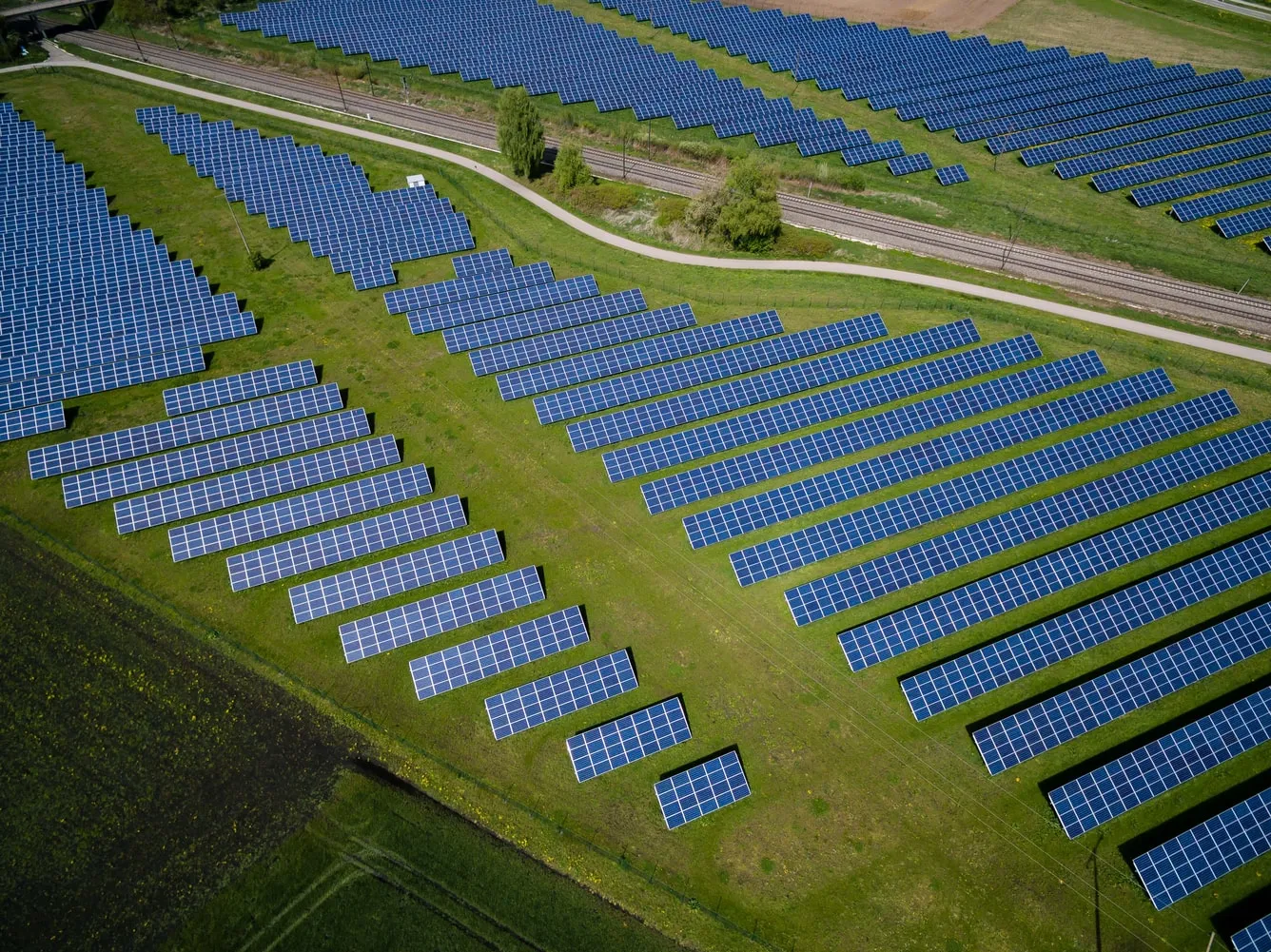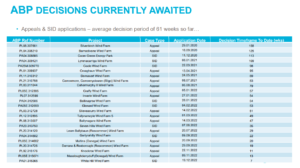Introduction
Planning has been identified by wind industry stakeholders as the greatest barrier to the development of renewable projects in Ireland[1]. The current state of affairs is dire, in 2021 the average wait time for decisions on appeals was 42 weeks, rising to an average of 58 weeks in 2022. For decisions relating to Strategic Infrastructure Development applications (SID), the 2021 average wait was 68 weeks, rising to 76 weeks in 202[2]. Regarding projects currently awaiting decisions, the average wait time for decisions on appeals and SID applications is 61 weeks. These delays increase the risk associated with developing in Ireland, add project costs and reduce renewable capacity available to the Island.
In his presentation at the Wind Energy Ireland Conference, Terry Sheridan from the Dept of Housing, Planning, Community and Local Government pointed to the economic growth of the country in the last number of years, adapting to developing and more complex legislation as well as legal challenges against decision making as significant causes of delay in the planning process.
He also referred to resourcing issues at An Bord Pleanála, with less than the standard compliment of ten Board members in place.
Organisation Reform
Reform is currently underway, the Planning and Development Bill 2023 outlines a new structure for An Bord Pleanála, which will be renamed to An Coimisiúin Pleanála[3]. The purpose of the new bill is to ‘set out a framework for a plan led system of planning and development based on integrated hierarchy of plan making and reflecting social, economic and environmental considerations’[4]. One of the key changes will see Ministerial planning guidelines and policy directives replaced with National Planning Statements and Policy Guidance – attempting to bring clarity and consistency to the implementation of national policy.
At an organisational level, the changes proposed will also see the replacement of the Chairperson and Board members with a Chief Planning Commissioner, Deputy Chief Commissioner and 13 Ordinary Planning Commissioners to be responsible for decisions around appeals, referrals, SID applications and other applications made directly to the board.
IROPI Consents
For developers and those seeking planning permission, the changes are more tangible. Noteworthy is the proposal for legislation on imperative reasons for overriding public interest (IROPI). This referrers to projects that will have adverse affects on the integrity of Special Areas of Conservation (SACs). It is proposed that projects can be carried out on these sites if no feasible alternative solutions exist, compensatory measures are adequate and the compensatory measures ensure that the overall coherence of Natura 2000 is protected[5]. These sites do not include areas that host priority species or priority habitats.
Section 183 (2)
“Where a relevant plan is necessary in order to enable –
(a)the construction or operation of plants producing energy from renewable sources,
(b)the storage of energy produced by such plants, or
(c)the connection of such plants to electricity, gas or heat grids, the competent authority shall presume that imperative reasons of overriding public interest exist for the carrying out of the plan.”[6]
This means that renewable energy projects, grid developments and storage facilities all have presumed IROPI exemptions, embedding the importance of renewable energy development in the planning system.
Judicial Review (JR) Reform
The proposed bill seeks to minimise the impact of JR on the developer, limiting those who can appeal to the courts as well as imposing timelines for a decision upon applications. The bill explains in section 249 that only parties with sufficient interest may apply to the courts, yet the parties outlined is wide ranging. Parties with a material interest, which is not limited to financial or land, who have been indirectly or directly affected are deemed as having sufficient interest. This will be a matter that if left undefined will be settled in the courts over time. NGO’s that are concerned with environmental issues, as set out in their constitution, have an assumed sufficient interest in the proposed legislation[7].
The mandatory timelines are clearer, determining set weeks for applications to be made, pleadings to be issued and the case to be decided upon. The Court is to deliver judgement on leave applications within 3 weeks of the hearing and 8 weeks after the application hearing, allowing for exemptions to be made as deemed necessary through higher courts[8].
Relating to Maritime Area Consent (MAC) applications, if the application goes to Judicial Review (JR), the applicant awaiting the decision may continue to apply for permission for development which may be granted. However, the permission for development will not take affect until the MAC JR challenge is determined or withdrawn[9]. It is not clear in the legislation if timelines for a JR decision outlined earlier apply to MAC applications and so delays in the courts may be of more significance for offshore wind and grid connection projects.
An Bord Pleanála Timelines
Under the bill, there will be statutory mandatory timelines for all consent processes to bring certainty to the planning consent processes. The statutory objective proposed is for ABP to make decisions on appeal cases and SID applications within a specified timeline, yet to be decided upon. Failing to meet the timelines set, the board must pay the applicant such sum as may be prescribed and publish a notice (online) that it has not made the decision within a specified time, detailing the reason why.
The current objective of ABP is to make decisions within 18 weeks, much lower than the current times being experienced. It will be interesting to see what pressure the reformed planning commission will place upon itself as the legislation is finalised.
Next Steps
The reforms proposed seek to mitigate some of the delays in the planning process, placing big asks on ABP. According to a recent Irish Times article, there is currently 70,000 homes awaiting planning permission, adding to the tasks of the Board while also implementing the new legislation[10].
Terry Sheridan indicated that they are expecting the bill to pass through a Joint Oireachtas Committee in early March, with the final bill to be published around Easter. It is the objective of the bill to be enacted before the summer recess. Planning regulations are also currently under revision with a view of finalisation by Autumn.
[1] Wind Energy Ireland Poll – ‘What do you believe is the single biggest challenge to building wind farms in Ireland? – 53% Voted the Planning System, 41% The Electricity Grid, 7% The Supply Chain, 0% Attracting Investment. 91 Respondents.’ Link (6) Tweets with replies by Wind Energy Ireland (@WindEnergyIRL) / Twitter
[2] Statkraft Presentation at WEI Conference 2023 – Statkraft – Proposed Development Structure with experienced resources ready to work on the BnM projects (amazonaws.com)
[3] Planning Issues – Thursday, 16 Feb 2023 – Parliamentary Questions (33rd Dáil) – Houses of the Oireachtas
[4] WEI Annual Conference Update on Planning Reforms (amazonaws.com)
[5] Strategic Plan 2020 – 2023 (amazonaws.com)
[6] Draft Planning and Development Bill 2022
[7] S249 Draft Planning and Development Bill 2022
[8] Statkraft – Proposed Development Structure with experienced resources ready to work on the BnM projects (amazonaws.com)
[9] Strategic Plan 2020 – 2023 (amazonaws.com)
[10] ‘Logjam’ of housing applications means swift resourcing of planning body essential, committee told – The Irish Times


